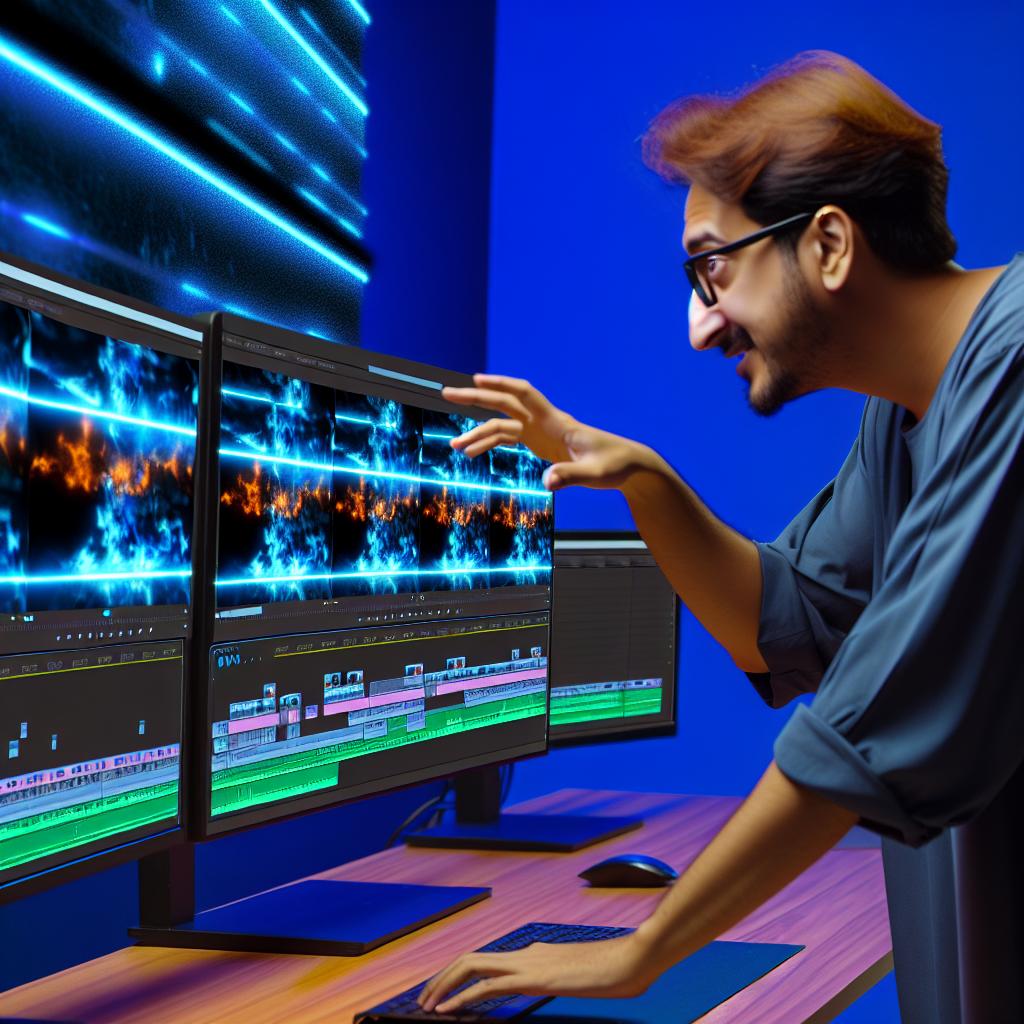Introduction
3D video editing techniques are gaining immense popularity in today’s digital age.
Content creators now embrace these methods to captivate audiences.
Social media platforms, streaming services, and advertising all benefit from 3D enhancements.
Viewers crave immersive experiences that traditional editing cannot offer.
Adding Depth and Dimension
3D video editing introduces depth that changes how audiences perceive visuals.
This technique allows editors to create layers and enhance the storytelling process.
Enhanced visuals engage viewers, making them feel like part of the action.
Sharp details and rich textures pull audiences into another world.
Techniques like motion tracking and virtual camera movement contribute to this realism.
The Viewer Experience
By incorporating 3D elements, editors heighten viewer engagement.
Audiences experience videos differently through spatial awareness.
They become more emotionally invested in the content being presented.
This increased engagement can lead to higher video shares and more interaction.
In a crowded media landscape, 3D techniques help content stand out.
Benefits of Learning 3D Techniques
Learning 3D video editing techniques opens new opportunities for creators.
It allows them to diversify their skill set and improve their marketability.
Jobs in film, gaming, and advertising increasingly require these skills.
Professionals can command higher fees for unique and immersive projects.
Additionally, mastering 3D editing might lead to exciting collaborations with other artists.
The creativity and innovation that come with 3D editing create dynamic content.
Transform Your Career Today
Unlock a personalized career strategy that drives real results. Get tailored advice and a roadmap designed just for you.
Start NowAs more creators adopt these techniques, viewers will expect higher quality on platforms.
Expanding your editing repertoire to include 3D techniques can significantly enhance your work.
Ultimately, diving into 3D video editing will enrich your storytelling and expand your artistic horizons.
The world of 3D video editing opens up exciting possibilities for creators.
Understanding its fundamentals lays a strong foundation for anyone looking to dive into this dynamic field.
Here, we explore the essential elements of 3D video editing, including its definition, tools, and the concepts that will elevate your work to the next level.
What is 3D Video Editing?
3D video editing refers to the process of manipulating three-dimensional video content.
Unlike traditional video editing, which uses flat, two-dimensional graphics and film, 3D editing incorporates depth and spatial relationships.
This distinction allows for more immersive experiences for viewers.
Traditional video editing relies on frame-by-frame techniques without depth perception.
Conversely, 3D video editing enhances viewer engagement by simulating a three-dimensional environment.
Users can create realistic simulations, rich animations, and lifelike visual effects that capture the audience’s attention.
The Tools and Software for 3D Video Editing
To get started with 3D video editing, you need the right tools and software. Here’s a list of essential items you’ll require:
- Computer: A powerful computer with a high-end graphics card is necessary to handle 3D rendering.
- 3D Modeling Software: Applications like Blender, Autodesk Maya, and Cinema 4D allow for creating and animating 3D models.
- Video Editing Software: Use programs like Adobe Premiere Pro or Final Cut Pro to combine 3D elements with traditional footage.
- Rendering Software: Tools like Octane Render or Arnold help produce high-quality final outputs from your 3D scenes.
- Audio Editing Software: Options like Audacity or Adobe Audition enhance the sound design of your 3D projects.
- Motion Capture Equipment: Devices that capture real-life movements help create realistic animations for character-driven projects.
Each software and tool plays a crucial role in simplifying the workflow.
Familiarizing yourself with these tools aids in maximizing creative possibilities and achieving professional results.
The Importance of Understanding Depth, Perspective, and Movement
In 3D video editing, grasping the concepts of depth, perspective, and movement is vital.
Each element contributes significantly to the overall experience you create for your audience.
1. Depth
Understanding depth allows you to simulate a three-dimensional space effectively.
Depth perception helps audience members discern the distance between foreground and background elements.
This awareness creates an emotional response and supports storytelling.
Showcase Your Business Today
Reach thousands of readers actively exploring professional services. Publish your business profile and grow your audience now.
Publish NowTechniques to enhance depth include:
- Layering: Place objects at various distances from the camera to reinforce depth.
- Depth of Field: Blur sharp elements to focus attention on a specific subject.
- Lighting: Use shadows and highlights to enhance the three-dimensionality of your scenes.
2. Perspective
Perspective defines how viewers interpret an image based on camera angle and positioning.
Altering perspective can create dramatic effects or emphasize certain elements in your video.
Familiarize yourself with different types of perspective:
- One-point perspective: Converges lines to a single point, often used in architectural shots.
- Two-point perspective: Involves two vanishing points for more dynamic scenes.
- Three-point perspective: Adds a vertical element, helpful in showcasing tall structures or dramatic angles.
3. Movement
The way objects move within a scene impacts the narrative and viewer engagement.
Understanding movement allows you to create fluid animations and interactions.
Keep these principles in mind:
- Animation Principles: Familiarize yourself with the 12 principles of animation to enhance realism.
- Camera Movement: Utilize techniques like pans, tilts, and dolly shots to guide viewer focus.
- Character Animation: Create believable character movements by applying weight and timing principles.
By mastering depth, perspective, and movement, you can elevate your 3D video editing skills.
These elements enrich the storytelling and create unforgettable visual experiences.
Creating Breathtaking Visuals
Embarking on a journey in 3D video editing demands a sturdy understanding of its fundamentals.
Defining 3D video editing as a process of creating immersive experiences is only the beginning.
Equipped with the right tools and the knowledge of depth, perspective, and movement, you’re ready to create breathtaking visuals.
Begin by exploring the recommended software and practicing the techniques outlined.
Embrace the complexity of 3D video editing and overcome challenges as you grow.
With determination and enthusiasm, your skills will evolve, bringing imaginative concepts to life.
Let creativity guide you as you navigate this captivating field.
Your commitment to understanding the essentials will pay off.
Soon, you will create stunning 3D videos that resonate with audiences far and wide.
With the emergence of 3D video editing, creators have more opportunities to enhance their storytelling.
This section explores essential techniques you can harness to create stunning visuals.
You will learn about parallax scrolling, depth mapping, and stereoscopy.
Each technique offers unique benefits and can elevate your video quality significantly.
Below, we will break down each method and provide step-by-step instructions.
Common 3D Video Editing Techniques
1. Parallax Scrolling
Parallax scrolling creates an illusion of depth by moving background and foreground layers at different speeds.
This technique brings your videos to life, giving them a dynamic feel.
Here’s how to implement parallax scrolling in your projects:
-
Gather Your Assets: Choose images or video clips with discernible foreground, middle ground, and background.
-
Import to Editing Software: Load your assets into your chosen video editing software.
-
Create Layers: Separate your images into different layers. Place the foreground layer on top, the middle layer beneath it, and the background layer at the bottom.
-
Adjust Layer Movement: Assign different movement speeds to each layer. Move the foreground layer faster than the background layer.
-
Keyframe Your Animation: Use keyframes to animate layer movement. Create depth by adjusting their positions over time.
-
Add Effects: Incorporate camera movement (like zooming or panning) for added realism.
2. Depth Mapping
Depth mapping involves creating a 3D map of your video’s spatial features.
It allows you to enhance depth perception in 2D videos.
Here’s a step-by-step guide to depth mapping:
-
Select Your Footage: Use footage that contains varied depth, such as landscapes or complex scenes.
-
Create a Depth Map: In your software, generate a grayscale depth map. Black represents the farthest objects, while white shows the closest.
-
Link Depth Map to Footage: Connect your depth map to your original footage. This connection enables the software to interpret depth accurately.
-
Animate Camera Movement: Simulate camera movement using your depth map. This adjustment gives the viewer a three-dimensional experience.
-
Fine-Tune Effects: Adjust brightness and contrast to enhance the depth perception for a professional look.
3. Stereoscopy
Stereoscopy generates a 3D effect by displaying two slightly different images, akin to how human eyes perceive depth.
This technique can mesmerize viewers when done correctly.
Follow these steps to apply stereoscopy:
-
Capture Footage: Record your shot using a stereoscopic camera or take two pictures from different angles.
-
Import Images: Load your captured footage or images into your video editing software.
-
Create Left and Right Channels: Separate the footage into two tracks, one for the left eye and one for the right eye.
-
Align Images: Ensure both images align perfectly for a strong 3D effect. Minor adjustments may be necessary.
-
Adjust Depth Settings: Modify the depth setting until the 3D effect appears natural. This setting can often be adjusted in the software’s stereoscopy menu.
-
Export Your Video: Save your finalized work in a suitable format that supports 3D display.
Tips and Tricks for Professional-Looking 3D Effects
Achieving professional-looking 3D effects requires practice and attention to detail.
Here are some tips to enhance your workflow:
-
Use High-Quality Assets: Begin with high-resolution images or videos. This practice ensures clarity in your final product.
-
Experiment with Lighting: Good lighting can dramatically improve the 3D effect. Experiment with shadows and highlights.
-
Keep It Subtle: Avoid overdoing 3D effects. Subtlety often leads to a more natural viewing experience.
-
Seek Feedback: Share your videos with peers or mentors. Constructive criticism can provide new perspectives.
-
Practice, Practice, Practice: Familiarize yourself with different software tools. The more you practice, the better your skills will become.
By mastering these three common 3D video editing techniques, you can significantly enhance your video content.
Whether you are creating a narrative, an advertisement, or an art piece, using parallax scrolling, depth mapping, and stereoscopy can bring your visuals to life.
Incorporate these methods into your projects, and watch your storytelling transform.
As you delve into 3D video editing, remember that experimentation is key.
Each project offers a unique opportunity to learn and innovate.
Explore various themes, styles, and techniques to find your distinct voice.
Showcase Your Business Today
Reach thousands of readers actively exploring professional services. Publish your business profile and grow your audience now.
Publish NowOver time, you will develop a confident approach to 3D editing that resonates with your audience.
Dive in and start creating captivating 3D experiences today!
See Related Content: How to Write Effective Ad Copy That Converts
Learning 3D video editing can seem daunting.
It becomes manageable through practice.
Start with simple projects to build a solid foundation.
This guide helps you explore sample projects and resources to kickstart your learning.
Getting Started with Sample Projects
Sample projects can ground your knowledge in 3D video editing.
Begin with tasks that require basic skills.
Here are a few suggestions:
- Create a 3D Title Animation: Make an animated title for a video using 3D text.
- Animate a Simple Object: Choose a basic shape and animate its movement in 3D space.
- Design a Short Scene: Model and animate a small scene, like a room or a park.
- Incorporate 3D Effects Into Existing Videos: Add 3D elements to a video clip you’ve recorded.
Each of these projects allows you to practice different aspects of 3D video editing.
Breaking the process into smaller tasks will help you learn better.
Utilizing Online Resources and Tutorials
Numerous online resources offer valuable guidance for sample projects.
Platforms like YouTube, Udemy, and Skillshare feature tutorials tailored to beginners.
Here are some popular routes to consider:
- YouTube Tutorials: Channels like ‘Blender Guru’ and ‘Jayanam’ provide insightful 3D editing tutorials.
- Online Courses: Websites like Udemy offer comprehensive courses on software like Blender and Cinema 4D.
- Community Forums: Join forums on Reddit or specialized sites to connect with other learners.
- Official Software Documentation: Visit the official sites for tools like Adobe After Effects for detailed guides.
Exploring these resources can deepen your understanding of 3D video techniques.
They cater to different learning styles and levels.
Follow along with projects to practice the skills you learn.
Encouraging Experimentation and Creativity
As you practice, don’t hesitate to experiment.
Creativity fuels innovation in 3D video editing.
Here’s how to foster your creative skills:
- Try Different Styles: Experiment with various artistic styles in your edits.
- Manipulate Colors: Adjust color settings to see how they impact your work.
- Mix Various Effects: Combine different 3D effects to create unique visuals.
- Explore New Tools: Test out new software or plugins that enhance your editing.
Experimenting with various elements while editing can help you discover your style.
Push your creative boundaries by trialing new ideas.
Learning from Feedback
Feedback plays a vital role in honing your skills.
Share your projects with friends or online communities.
Use constructive criticism to refine your work.
Here are some ways to gather feedback:
- Join Online Communities: Engage in platforms like Facebook groups or forums to share your projects.
- Host a Screening: Organize a casual viewing with friends to showcase your work.
- Request Constructive Critique: Ask for specific feedback to focus on improvement areas.
- Participate in Challenges: Engaging in challenges can prompt valuable feedback from peers.
Utilizing feedback enables you to learn from others’ perspectives.
This practice accelerates your growth in 3D video editing.
Building a Routine for Continuous Learning
Establishing a consistent practice routine enhances your skills.
Set aside time weekly to focus on 3D video editing.
Here’s a recommended plan:
- Practice Regularly: Dedicate at least two hours a week solely for 3D editing.
- Set Clear Goals: Outline what you want to achieve in each session.
- Keep a Journal: Document your projects and the skills you used or need improvement.
- Update Your Skills: Stay informed on new techniques or technology trends in video editing.
By developing this routine, you’ll see marked improvement over time.
Consistency is key to mastering any skill, including 3D video editing.
Embrace Your 3D Editing Journey
Starting with 3D video editing can be a rewarding journey.
Practice with sample projects while exploring online resources.
Embrace creativity in your projects and remain open to learning.
Engaging in feedback loops and maintaining a learning routine can solidify your skills.
3D video editing opens avenues for storytelling and visual creativity.
The more you practice, the more proficient you’ll become in creating stunning visuals.
Showcase Your Business Today
Reach thousands of readers actively exploring professional services. Publish your business profile and grow your audience now.
Publish NowEmbark on your editing journey with enthusiasm.
Remember to enjoy the process of learning and creating.
Each project provides an opportunity to refine your techniques and express your unique vision.
Delve into the Subject: Top Tools for Print Production Managers
As you delve deeper into 3D video editing, you will encounter a range of advanced techniques that can significantly enhance your projects.
Mastering these complex methodologies such as 3D motion tracking, CGI integration, and 3D compositing will elevate your skill set.
This section explores these techniques and provides essential insights to help refine your art form.
Understanding 3D Motion Tracking
3D motion tracking allows you to analyze the movement of objects within a video.
This capability enables you to insert 3D elements seamlessly into live-action footage.
The following points outline the significance of motion tracking:
- Integration of 3D Elements: You can create realistic interactions between live footage and digital objects.
- Enhanced Depth: The technique adds depth to your video, enriching the viewer’s experience.
- Dynamic Environment: Motion tracking fosters a dynamic environment, allowing objects to react realistically to the scene.
To implement motion tracking, follow these steps:
- Import your footage into a compatible software.
- Track the points of interest in the video, identifying key features for the software.
- Create an animation or 3D model to insert into the scene.
- Position the 3D element according to the tracked movements.
- Refine the matching anchor points to ensure seamless integration.
Exploring CGI Integration
Computer Generated Imagery (CGI) integration is indispensable for creators.
This technique enables you to blend real footage with digitally crafted elements.
The benefits of mastering CGI include:
- Creative Freedom: You can visualize concepts that would be impossible in real life.
- Visual Variety: Incorporate diverse elements, adding vibrancy to your videos.
- Control Over Every Detail: CGI allows you to meticulously craft each frame, enhancing quality.
To successfully integrate CGI, consider these guidelines:
- Design your CGI objects with attention to detail.
- Use realistic texturing and lighting to match the environment.
- Pay close attention to shadows and reflections for optimal realism.
- Synchronize movements between CGI and live-action footage.
- Continuously refine your composition until you achieve the desired effect.
Mastering 3D Compositing
3D compositing involves layering different visual elements to create a cohesive final product.
This process is fundamental in film production and high-quality video creation.
The importance of 3D compositing includes:
- Seamless Transitions: You can create smooth transitions between scenes and elements.
- Visual Storytelling: Compositing empowers you to tell deeper stories through integrated visuals.
- Control Over Multiple Layers: Manage various layers for more complex scenes and narratives.
To improve your compositing skills, take these steps:
- Import your various video layers into compositing software.
- Organize the layers according to your vision and design.
- Utilize masking tools to isolate specific elements efficiently.
- Adjust opacity, color grading, and effects on each layer.
- Export your composition after thorough review and adjustments.
The Importance of Mastering Advanced Techniques
Understanding and mastering these advanced techniques enhances your overall video editing capabilities.
Here are three reasons to prioritize this skill development:
- Professional Opportunities: High-quality video production skills are highly sought after in creative industries.
- Improved Project Outcome: Applying advanced techniques results in visually stunning content, setting you apart.
- Stronger Portfolio: Showcasing projects that utilize complex methods attracts potential clients and collaborators.
Advanced Tips for Improvement
Here are some advanced tips to help refine your skills further:
- Regularly Update Software: Stay current with the latest tools and updates to keep your skills relevant.
- Practice with Real Projects: Apply your skills to real-world scenarios to enhance experience.
- Study Existing Work: Analyze other creators’ work to understand their techniques and ideas.
- Engage with Communities: Collaborate with other editors to gain new insights and feedback.
- Take Online Courses: Pursue advanced training to cover new concepts and techniques.
Resources for Further Learning and Practice
Consider utilizing the following resources to expand your knowledge and practice:
- Online Learning Platforms: Websites like Udemy or Skillshare offer extensive courses on advanced video editing.
- YouTube Tutorials: Many pros share valuable tips and tricks through video content that’s easily accessible.
- Industry Forums: Join platforms such as Reddit or professional groups on Facebook to network with peers.
- Software Documentation: Refer to user manuals and forums for specific software to enhance your understanding.
- Practice Projects: Challenge yourself with themed projects that utilize multiple advanced techniques.
Embarking on your journey of mastering these advanced 3D video editing techniques demands practice and dedication.
With the right mindset, resources, and commitment, you can produce captivating and high-quality 3D videos that resonate with audiences.
Continue to explore, learn, and develop your creative voice within this dynamic realm.
Delve into the Subject: How to Start a Career as an Advertising Copywriter

When stepping into the world of 3D video editing, collaboration becomes essential.
Working with fellow professionals brings numerous benefits.
The filmmaking landscape constantly evolves, and sharing knowledge speeds up your growth.
Networking amplifies your learning and exposure to different techniques and styles.
Benefits of Networking with Other 3D Video Editors and Filmmakers
Networking plays a crucial role in professional development.
Engaging with others helps you hone your craft effectively.
Here are some key benefits:
-
Increased Creativity: Collaborating with others inspires fresh ideas and perspectives.
-
Skill Development: Learning from seasoned practitioners helps enhance your editing skills.
-
Access to Resources: Fellow professionals often share valuable tools and resources.
-
Job Opportunities: Networking often leads to job referrals and project collaborations.
-
Support and Motivation: Being part of a community provides encouragement.
Networking enhances not only your skills but also your confidence.
The more you interact with other creators, the more comfortable you become discussing your work and ideas.
How to Join Online Communities
Participation in online communities can significantly boost your networking efforts.
Several platforms cater specifically to 3D video editing enthusiasts.
Here’s how to get started:
-
Find Relevant Forums: Search for discussion boards dedicated to 3D editing.
-
Join Social Media Groups: Platforms like Facebook and LinkedIn host groups focused on video editing.
-
Participate in Online Courses: Many courses not only teach editing but also facilitate community interaction.
-
Follow Influencers: Identify industry leaders on platforms like Instagram and YouTube.
When participating in these communities, be genuine and respectful.
Showcase Your Business Today
Reach thousands of readers actively exploring professional services. Publish your business profile and grow your audience now.
Publish NowShare your insights but also be open to learning from others.
Attend Workshops and Networking Events
In-person workshops and events allow you to meet professionals face-to-face.
These gatherings can provide deeper connections and hands-on learning.
Here are steps to make the most of these events:
-
Research Events: Look for local or virtual workshops dedicated to 3D video editing.
-
Prepare Your Portfolio: Keep a selection of your best work ready to share.
-
Be Open to Conversations: Attend with the intent to learn from others.
-
Follow Up: After meetings, send follow-up messages to the people you connect with.
Workshops provide a platform for learning and collaboration.
Engaging actively increases your chances of productive partnerships.
Collaborating on Projects
Engaging in projects with fellow professionals enhances your editing repertoire.
Collaboration fosters creativity and introduces you to new techniques.
Here’s how you can seek collaborations:
-
Reach Out: Contact other editors whose work you admire.
-
Utilize Collaboration Platforms: Websites like FilmFreeway connect filmmakers and editors.
-
Attend Local Meetups: Meetups can result in immediate collaboration opportunities.
-
Join a Creative Collective: Look for local collectives that focus on filmmaking.
Collaboration can lead to unexpected results.
The experience not only improves your skills but often produces higher quality work.
Sharing Knowledge and Skills
The spirit of sharing knowledge is vital in the 3D editing community.
Teaching others solidifies your understanding and enhances your expertise.
Here are effective ways to share knowledge:
-
Host Workshops: If you feel confident in your skills, consider hosting workshops.
-
Blog or Vlog: Create content around your learning experiences.
-
Mentor Aspiring Editors: Offer guidance to those just starting.
-
Engage in Case Studies: Analyze your projects and share insights.
When you share your successes and failures, you contribute to the growth of the entire community.
Giving back is essential to personal and communal development.
See Related Content: Key Metrics Media Planners Use to Track Success
As you delve into 3D video editing, showcasing your skills becomes essential.
A well-curated portfolio helps express your unique style and expertise.
This section will guide you in creating an impressive portfolio, marketing your skills, and utilizing social media effectively.
Creating a Strong Portfolio
Your portfolio serves as a visual representation of your work.
It allows potential clients and employers to understand your capabilities.
A strong portfolio highlights your best 3D video editing projects.
Follow these steps to create an engaging portfolio:
- Select Your Best Work: Choose 4 to 6 of your most impressive projects.
- Diverse Styles: Include a variety of styles and techniques.
- Quality Over Quantity: Prioritize quality over the number of projects displayed.
- Update Regularly: Keep your portfolio up-to-date.
- Highlight Collaborations: If you worked on team projects, showcase them.
Building an Online Portfolio
Creating an online portfolio helps you attract a wider audience.
Follow these tips to design an effective online platform:
- Choose the Right Platform: Use platforms like Behance, Vimeo, or your own website.
- Include Clear Descriptions: For each project, write clear summaries.
- Add High-Quality Thumbnails: Use eye-catching thumbnails.
- Incorporate Video Clips: If possible, include short video clips.
- Optimize for Search Engines: Use relevant keywords in your website content.
Creating a Demo Reel
A demo reel is a powerful tool in showcasing your work.
It compiles your best moments into a short, engaging video.
Here is how to create an impactful demo reel:
- Keep it Short: Aim for 1 to 2 minutes.
- Start Strong: Open with your best work.
- Show Variety: Highlight different styles and techniques within your reel.
- End with Contact Information: Conclude with your name and contact details.
- Get Feedback: Before finalizing, seek feedback from peers.
Marketing Yourself as a 3D Video Editor
Once you have your portfolio ready, it’s time to market yourself.
Here are effective strategies to promote your 3D video editing services:
- Build a Personal Brand: Define your unique selling points.
- Network with Industry Professionals: Attend industry events, workshops, or webinars.
- Join Online Communities: Participate in forums and groups related to video editing.
- Share Your Work: Regularly share your projects on social media.
- Collaboration Opportunities: Collaborate with other creators.
Leveraging Social Media
Social media is a valuable tool for reaching a broader audience.
Implement these strategies to maximize your social media presence:
- Choose the Right Platforms: Focus on platforms where your target audience is active.
- Regular Posting Schedule: Develop a consistent posting schedule.
- Use Hashtags Wisely: Research and use relevant hashtags.
- Engage with Your Audience: Respond to comments and messages.
- Show Behind-the-Scenes Content: Sharing your process can attract followers.
Showcasing your 3D video editing skills requires careful planning and execution.
A well-constructed portfolio illustrates your abilities.
Creating an online portfolio or demo reel helps attract clients.
To succeed, actively market yourself and leverage social media.
By following these steps, you position yourself as a competitive 3D video editor in the industry.
Key Steps for 3D Video Editing
In this blog post, we explored the essential steps to get started with 3D video editing techniques.
We discussed the importance of selecting suitable software and familiarizing yourself with its interface.
Showcase Your Business Today
Reach thousands of readers actively exploring professional services. Publish your business profile and grow your audience now.
Publish NowUnderstanding the basic concepts of 3D modeling and animation is crucial for success.
You should also practice using different tools and features to enhance your creativity.
We emphasized the role of tutorials and online resources in expanding your knowledge.
Joining forums or communities can provide support and inspiration.
Remember to put your skills to the test by engaging in projects that challenge you.
Experimentation allows for growth and the discovery of your personal editing style.
Starting your journey into 3D video editing opens doors to endless possibilities.
The skills you gain will benefit you in various digital media fields, from filmmaking to video game design.
As digital media evolves, having 3D editing skills makes you a more competitive candidate in the job market.
Now is the perfect time to dive into 3D video editing.
Embrace the learning process and enjoy every step of your journey.
Explore, practice, and create captivating visual stories that resonate with your audience.
By mastering 3D video editing, you not only enhance your technical abilities but also expand your creative horizons.
Take the plunge, and let your imagination guide you.
Your future projects will benefit immensely from your dedication and effort.
Additional Resources
School of Communication Undergraduate Programs | University …
I want to learn video editing, how should I start? Which application is …
[E-Books for Sale]
The Big Book of 500 High-Paying Jobs in America: Unlock Your Earning Potential
$19.99 • 500 High-Paying Jobs • 330 pages
Explore 500 high-paying jobs in America and learn how to boost your career, earn more, and achieve success!
See All 500 High-Paying Jobs of this E-Book
1001 Professions Without a Degree: High-Paying American Jobs You Can Start Now
$19.99 • 1001 Professions Without a Degree • 174 pages
Discover 1001 high-paying jobs without a degree! Unlock career tips, skills, and success strategies for just $19.99!




